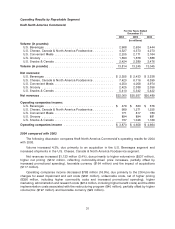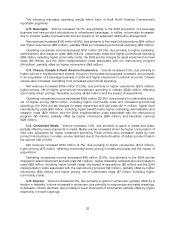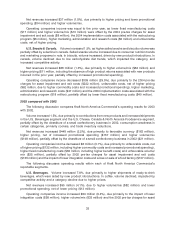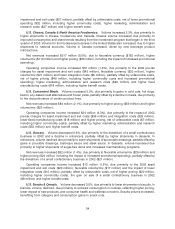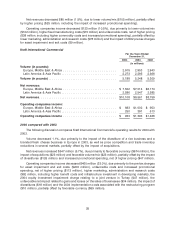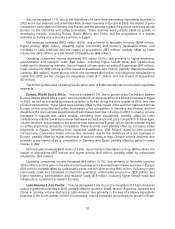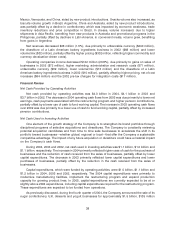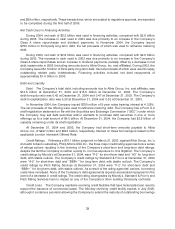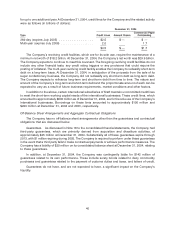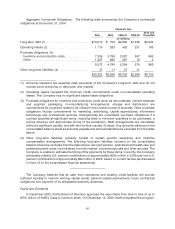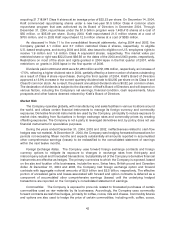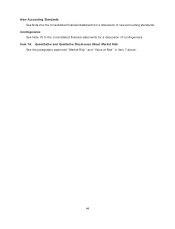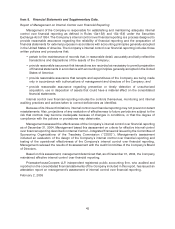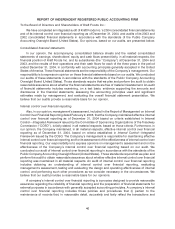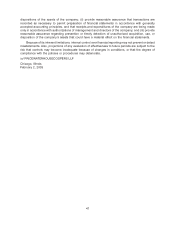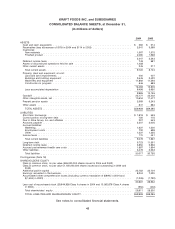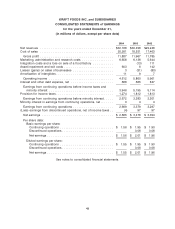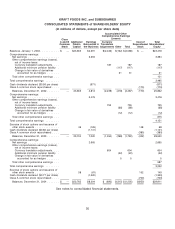Kraft 2004 Annual Report Download - page 42
Download and view the complete annual report
Please find page 42 of the 2004 Kraft annual report below. You can navigate through the pages in the report by either clicking on the pages listed below, or by using the keyword search tool below to find specific information within the annual report.
Aggregate Contractual Obligations. The following table summarizes the Company’s contractual
obligations at December 31, 2004:
Payments Due
2010 and
Total 2005 2006-07 2008-09 Thereafter
(in millions)
Long-term debt (1) ....................... $10,513 $ 750 $2,663 $1,456 $5,644
Operating leases (2) ...................... 1,110 283 403 231 193
Purchase obligations (3):
Inventory and production costs ............. 7,306 3,799 2,087 557 863
Other ............................... 1,267 985 267 13 2
8,573 4,784 2,354 570 865
Other long-term liabilities (4) ................ 37 11 15 11
$20,233 $5,828 $5,435 $2,268 $6,702
(1) Amounts represent the expected cash payments of the Company’s long-term debt and do not
include bond premiums or discounts, and interest.
(2) Operating leases represent the minimum rental commitments under non-cancelable operating
leases. The Company has no significant capital lease obligations.
(3) Purchase obligations for inventory and production costs (such as raw materials, indirect materials
and supplies, packaging, co-manufacturing arrangements, storage and distribution) are
commitments for projected needs to be utilized in the normal course of business. Other purchase
obligations include commitments for marketing, advertising, capital expenditures, information
technology and professional services. Arrangements are considered purchase obligations if a
contract specifies all significant terms, including fixed or minimum quantities to be purchased, a
pricing structure and approximate timing of the transaction. Most arrangements are cancelable
without a significant penalty, and with short notice (usually 30 days). Any amounts reflected on the
consolidated balance sheet as accounts payable and accrued liabilities are excluded from the table
above.
(4) Other long-term liabilities primarily consist of certain specific severance and incentive
compensation arrangements. The following long-term liabilities included on the consolidated
balance sheet are excluded from the table above: accrued pension, postretirement health care and
postemployment costs, income taxes, minority interest, insurance accruals and other accruals. The
Company is unable to estimate the timing of the payments for these items. Currently, the Company
anticipates making U.S. pension contributions of approximately $250 million in 2005 and non-U.S.
pension contributions of approximately $90 million in 2005, based on current tax law (as discussed
in Note 15 to the consolidated financial statements).
The Company believes that its cash from operations and existing credit facilities will provide
sufficient liquidity to meet its working capital needs, planned capital expenditures, future contractual
obligations and payment of its anticipated quarterly dividends.
Equity and Dividends
In December 2003, Kraft’s Board of Directors approved the repurchase from time to time of up to
$700 million of Kraft’s Class A common stock. On December 14, 2004, Kraft completed the program,
41


